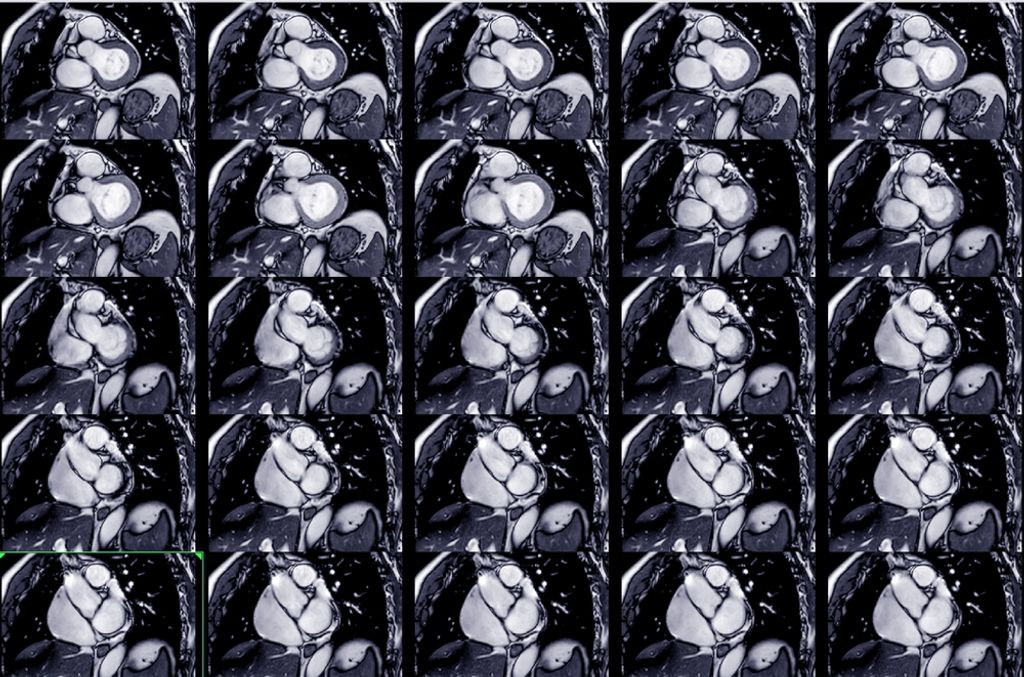A groundbreaking study has revealed the potential of cardiovascular magnetic resonance (CMR) imaging as a non-invasive tool for assessing heart failure risk. By accurately estimating pulmonary capillary wedge pressure (PCWP), a key indicator of heart failure, CMR can identify individuals at risk early on, enabling timely intervention. This article explores the implications of this breakthrough and discusses the potential benefits of using CMR for heart health assessment (1).
Introduction
Heart failure is a serious and debilitating condition that occurs when the heart is unable to pump blood effectively, leading to a range of symptoms, including shortness of breath, fatigue, and swelling in the legs and abdomen (2). It is a significant public health concern worldwide, with millions of people affected by this condition.
Early detection and prevention are crucial for improving outcomes for individuals at risk of heart failure. Traditionally, assessing heart risk often involved invasive procedures, such as cardiac catheterisation, which can be uncomfortable and carry risks of complications (1).
However, advancements in medical technology have led to the development of non-invasive methods for assessing heart risk, such as imaging techniques and blood tests. These methods allow for earlier detection of heart issues, leading to more timely interventions and better patient outcomes (1).
CMR As A Non-Invasive Alternative

CMR imaging, a non-invasive imaging technique that uses magnetic fields and radio waves to create detailed images of the heart, has emerged as a promising alternative for assessing heart health. By providing high-quality images of the heart’s structure and function, CMR can help identify abnormalities that may indicate an increased risk of heart failure (3).
Estimating Pulmonary Capillary Wedge Pressure
PCWP is an important indicator of the pressure on the left side of the heart, particularly filling pressure, which is a crucial factor in the development of heart failure. An insightful study has showcased that CMR imaging can effectively gauge PCWP by examining various parameters, including left atrial volume and ventricular mass (4).
Study Findings
Researchers from the UK Biobank conducted a thorough cardiovascular magnetic resonance (CMR) data analysis from many participants. Their findings revealed a compelling link between elevated CMR-modelled pulmonary capillary wedge pressure (PCWP) and a heightened likelihood of experiencing heart failure and major adverse cardiovascular events (MACE). Remarkably, this association remained significant even after adjusting for common risk factors such as age, gender, hypertension, obesity, and diabetes, all of which are widely recognised as contributors to heart failure (1).
Implications for Heart Health Care
This research results have important implications for heart health. By identifying individuals who are at a high risk of developing heart failure at an early stage, healthcare professionals can implement preventive strategies and start treatment sooner. This proactive approach could enhance patient outcomes and overall heart health care (1).
Benefits of Using CMR for Heart Risk Assessment
- Non-invasive: CMR, a safe and painless procedure, eliminates the need for invasive measures, reassuring patients and healthcare providers (1).
- Accurate: The CMR-derived model accurately predicted PCWP and heart failure risk (1).
- Early detection: CMR’s ability to identify individuals at risk of heart failure before symptoms appear empowers healthcare providers to take proactive measures, instilling a sense of control and preparedness (1).
- Risk stratification: CMR’s role in stratifying individuals based on their risk of heart failure is instrumental in guiding treatment decisions and instilling confidence in the chosen course of action (1).
- Diagnose many different heart conditions, including tissue damage from a heart attack, reduced blood flow in the heart muscle, inflammation in the myocardium, problems in the aorta, pericardium diseases, heart muscle diseases, heart valve disorders, and congenital heart problems (2).
The Role of CMR in Heart Failure Management
In addition to predicting heart failure risk, CMR can be valuable in managing heart failure patients. It can help assess the severity of heart failure, monitor the effectiveness of treatment, and identify potential complications (1).
CMR and Heart Failure Diagnosis
CMR can be used to diagnose various types of heart failure, including ischemic, cardiomyopathic, and valvular heart disease. By providing detailed images of the heart’s structure and function, CMR can help identify the underlying cause of heart failure (1), (2), (3).
CMR and Heart Failure Prognosis
CMR can also help predict the prognosis of heart failure patients. By assessing the severity of heart damage and the presence of complications, CMR can provide valuable information for making treatment decisions (1), (3).
CMR and Treatment Monitoring
CMR can monitor the effectiveness of heart failure treatments, such as medications, cardiac resynchronisation therapy (CRT), and implantable cardioverter defibrillators (ICDs). By tracking changes in heart function over time, CMR can help determine if a treatment is working or adjustments are needed (1), (3).
CMR and Heart Failure Complications
CMR can also help identify potential complications of heart failure, such as heart rhythm abnormalities, blood clots, and pericardial effusion. Early detection of these complications can lead to more effective treatment and improved outcomes (1).
Addressing Potential Limitations and Challenges
While CMR offers significant benefits for heart health assessment, there are some potential limitations and challenges.
- Cost: CMR can be more expensive than some other imaging techniques, which may limit its availability in certain settings.
- Accessibility: CMR may not be readily available in all regions, particularly in rural areas or developing countries.
- Technical limitations: Some individuals may not be suitable for CMR due to claustrophobia, metal implants, or certain medical conditions.
Despite these limitations, CMR is a valuable tool for assessing and managing heart failure. As technology advances, CMR is likely to become even more accessible and affordable (1).
Future Research and Clinical Applications
Further research is needed to explore CMR’s full potential in heart health care. Future studies may investigate its cost-effectiveness for heart risk assessment, its impact on patient outcomes, and its role in guiding treatment decisions.
In addition, ongoing research is focused on developing new CMR techniques and applications. For example, researchers are exploring the use of CMR to assess cardiac metabolism, myocardial perfusion, and tissue fibrosis. These techniques provide additional insights into the underlying causes of heart failure and help guide treatment decisions (1).
Conclusion
Cardiovascular magnetic resonance imaging offers a promising new tool for detecting, diagnosing, and managing heart failure. By accurately assessing heart risk and providing valuable information about heart function, CMR can help improve outcomes for individuals with heart failure. As technology advances, CMR will likely play an increasingly important role in heart health care.
Disclaimer: The content provided on this platform is intended for informational purposes only and does not replace professional medical advice, diagnosis, or treatment. Some materials may originate from third-party sources, and the views expressed are solely those of the respective authors or entities, not Docquity. Docquity does not warrant the accuracy, reliability, or completeness of the content and disclaims any responsibility for it. Users are advised to independently verify all information before acting upon it.
References
- Thomson RJ, Ciaran Grafton‐Clarke, Matthews G, et al. Risk factors for raised left ventricular filling pressure by cardiovascular magnetic resonance: Prognostic insights. ESC Heart Failure. 2024 Aug 12. DOI: https://doi.org/10.1002/ehf2.15011.
- American Heart Association. What is heart failure? [Internet]. www.heart.org. American Heart Association; 2023. Available from: https://www.heart.org/en/health-topics/heart-failure/what-is-heart-failure
- American Heart Association. Magnetic Resonance Imaging (MRI) [Internet]. www.heart.org. 2015. Available from: https://www.heart.org/en/health-topics/heart-attack/diagnosing-a-heart-attack/magnetic-resonance-imaging-mri
- Nair R, Lamaa N. Pulmonary Capillary Wedge Pressure [Internet]. PubMed. Treasure Island (FL): StatPearls Publishing; 2022. Available from: https://www.ncbi.nlm.nih.gov/books/NBK557748/#:~:text=Pulmonary%20capillary%20wedge%20pressure%20is%20an%20integrated%20measurement%20of%20the
About Docquity
If you need more confidence and insights to boost careers in healthcare, expanding the network to other healthcare professionals to practice peer-to-peer learning might be the answer. One way to do it is by joining a social platform for healthcare professionals, such as Docquity.
Docquity is an AI-based state-of-the-art private & secure continual learning network of verified doctors, bringing you real-time knowledge from thousands of doctors worldwide. Today, Docquity has over 400,000 doctors spread across six countries in Asia.
Meet experts and trusted peers across Asia where you can safely discuss clinical cases, get up-to-date insights from webinars and research journals, and earn CME/CPD credits through certified courses from Docquity Academy. All with the ease of a mobile app available on Android & iOS platforms!







